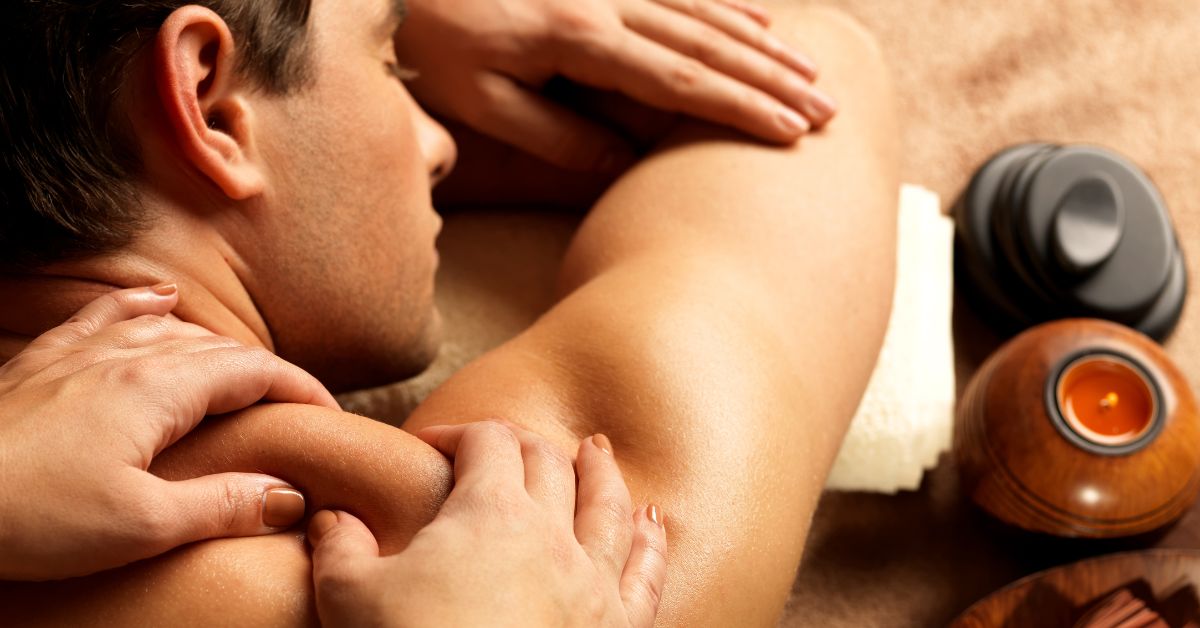
What Is a Deep Tissue Massage? Benefits, Techniques & What to Expect
Introduction
Stress, muscle tension, and chronic aches and pains are an unfortunate part of modern life. Increasingly, people are turning to massage therapy, also known as intense tissue massage, to combat stress.
Whether you’re an office worker who regularly pops Advil for a sore neck or a fitness enthusiast trying to recover after an intense workout, deep tissue massage can help.
If you are still wondering whether or not this powerful treatment is for you, this comprehensive deep tissue massage guide from Spa180 Prestige can help:
In this blog, you’ll learn about:
- What is a deep tissue massage
- The techniques we use and how they work
- The top key benefits
- What you can expect during and after your treatment
- Who it’s best suited for (and who should avoid it)
- How it stacks up against other massage types
- And why Spa 180 Prestige is the right place for you to get one
What Is a Deep Tissue Massage?
A deep tissue massage is a massage that targets the deeper layers of muscles and the connective tissues that surround them. Slow, firm strokes and friction are applied to help release the tension and knots in the muscles and fascia of the body.
A deep tissue massage is excellent for:
- chronic pain
- back pain
- neck stiffness and shoulder tightness
- muscle injuries and strain
- recovery from workouts and sports activities
- correcting poor posture
Swedish massage is not as deep as deep tissue massage.
How Does Deep Tissue Massage Work?
The goal of deep tissue massage is to break down muscle adhesions, knots, and tension by applying deep pressure and using specific techniques and strokes on the soft tissues of the body.
Deep tissue massage works in several ways to provide relief:
- Breaks down adhesions: Over time, the muscle can develop adhesions (knots or bands of rigid tissue) due to injury, overuse, lack of activity, poor posture, and other factors. Deep tissue massage helps to break these down.
- Improves blood and oxygen flow: The firm massage strokes help increase circulation, which in turn allows muscles to heal faster and function more effectively.
- Flushes out toxins: Stimulating the lymphatic system and improving circulation helps flush out the waste and metabolic byproducts from the muscle cells
- Supports natural healing: By releasing the tight muscle fibers, the body can return to the natural movement patterns, which support better mechanics and body functions
- Fixes repetitive strain and posture: Whether you sit for hours at a desk or are on your feet all day, deep tissue massage can address the long-term tension and help restore balance and symmetry to your body
Techniques Used in Deep Tissue Massage
Our experienced therapists at Spa 180 Prestige employ a combination of targeted deep-tissue massage techniques to deliver effective treatments while minimizing discomfort.
Standard deep tissue massage techniques include:
- Stripping: This deep tissue massage technique involves deep, gliding pressure along the length of the muscle fibers, usually using the forearm or thumbs. The deep pressure and motion help stretch and lengthen tight muscles.
- Friction: This involves applying pressure perpendicular to the muscle fibers to break up adhesions and scar tissue. Friction massage can be intense, but it’s very effective.
- Trigger Point Therapy: Trigger point therapy is a deep massage that focuses on specific trigger points or “knots” in the muscles, which can refer pain to other parts of the body. By applying focused pressure, we can release the tension and improve the range of motion.
We also use our elbows, knuckles, and forearms to apply deep, therapeutic pressure into the muscles without straining you.
💡 Comparison with Swedish massage: Swedish massage is one of the most popular types of massages, with a general focus on promoting Relaxation. It uses light to moderate pressure to knead and soothe the muscles. On the other hand, deep tissue massage uses firm to intense pressure and focuses on therapeutic pain relief and recovery
Benefits of Deep Tissue Massage
Deep tissue massage can help you recover from an injury, manage stress, and improve overall function. Many of our clients come to Spa 180 Prestige for this popular massage therapy.
Here are the top key benefits:
- Chronic pain relief: A deep tissue massage is ideal for individuals who experience persistent pain and discomfort in the lower back, shoulders, neck, hips, or legs. It targets the root cause — the muscular tension — instead of masking the pain.
- Improved mobility and flexibility: Tight muscles and fascia (connective tissue) can cause stiffness and immobility. By releasing this tightness, deep tissue massage often leads to increased range of motion and a greater feeling of freedom of movement.
- Injury recovery: A deep tissue massage can help to accelerate recovery from:
- sports injuries,
- sprains and strains, and repetitive strain injuries, such as tennis elbow
- Stress and tension relief: Although deep tissue massage may sound like the opposite of a relaxing massage, it does promote deep Relaxation. Deep tissue massage can trigger the parasympathetic nervous system, also known as “rest and digest,” and can help lower cortisol (stress hormone) levels.
- Posture correction: A deep tissue massage is also excellent for individuals who sit at a desk or have repetitive movements as part of their job. Deep tissue massage works by realigning chronically tight muscles and, over time, may lead to improved posture.
- Improved circulation and oxygen delivery: Better blood circulation means more oxygen and nutrients are delivered to the tissues of the body, which is essential for healthy muscles and recovery
Is Deep Tissue Massage Painful? What to Expect During and After
Will deep tissue massage hurt?
This is one of the most common questions we get, and the answer is:
YES and NO.
You will experience intense pressure, especially in areas with a lot of tension and knots, during the massage. But you should not feel sharp or unbearable pain.
The pressure should feel more like a “good hurt” rather than a “bad hurt.”
Mild soreness is common the next day, and many of our clients have likened it to post-workout soreness. It’s an entirely normal response as your muscles adjust to being released of tension and adhesions.
How long does it last?
The soreness should last 24–48 hours, after which our clients report feeling relaxed, loose, and more mobile.
What else should I expect?
- Drink plenty of water to help flush out toxins.
- Engage in gentle stretching to maintain flexibility.
- Avoid intense physical activity for the next 24 hours.
Who Should (and Shouldn’t) Get a Deep Tissue Massage?
A deep tissue massage is ideal for:
- People who suffer from chronic pain or tension in their muscles
- Athletes and fitness enthusiasts
- Those who work at a desk job or with repetitive movement patterns that lead to poor posture
- People recovering from previous injuries or repetitive strain injuries
Deep tissue massage may not be suitable for:
- Individuals with blood clotting disorders, osteoporosis, or skin infections
- Those who have had recent surgeries or have open wounds
If you’re pregnant, a therapist trained in prenatal massage can perform deep tissue massage.
Otherwise, we advise you to stay away.
As with any therapeutic intervention, we recommend consulting a qualified massage therapist or your doctor if you have any concerns or underlying health conditions before beginning deep tissue massage.
Deep Tissue Massage vs Other Massage Types
We’ve created this table to help you understand how deep tissue massage compares to other types of massages:
Massage TypePressure LevelPurposeBest For
Deep Tissue Firm to intense. Relieves pain by breaking adhesions, improving blood flow to muscles, and flushing out toxins—chronic pain, injury recovery, sports massage, etc.
Swedish Massage Light to moderate Relaxation and stress relief. Deep Relaxation and Well-being
Sports Massage Varies: Pre/post-event muscle care, flexibility, and injury prevention. Athletes, sports injury recovery.
Trigger Point Therapy: Localized Tension and pain relief at specific points. Specific pain points, tight areas
Myofascial Release: Gentle to moderate. Stimulates fascia and increases range of motion, flexibility, and blood flow. Chronic muscle tightness, posture improvement
Why Choose Spa 180 Prestige for Your Deep Tissue Massage?
Spa 180 Prestige takes a holistic and highly custom approach to deep tissue massage, moving far beyond a standard treatment.
And we’ve got the credentials to back it up.
Here’s why our clients keep coming back for more:
Certified, experienced therapists: Our team is not only highly qualified with advanced training and credentials in multiple modalities, but they also have an in-depth knowledge of human anatomy.
Customised treatment plans: Every client is different, and every session should be too. Our team will work with you to customise your session.
Private and peaceful environment: We take pride in pampering you, so relax and enjoy your treatment in a tranquil, spa-like setting.
Clean, luxurious facility: Hygiene and comfort are our top priorities, which is why we invest a lot of resources into ensuring everything at Spa 180 Prestige is pristine.
Flexible bookings and follow-up care: We have flexible appointment slots for you to choose from, and our team is on hand to guide you with expert tips for post-massage care and recovery.
FAQs About Deep Tissue Massage
Q1. How often should I get a deep tissue massage?
A1: It depends on your needs. For general maintenance, once every two to four weeks is great. If you have a chronic issue, we often recommend that clients have weekly sessions initially.
Q2. Can deep tissue massage help improve posture?
A2: Absolutely, by releasing the tight muscles that pull your body out of alignment, you will slowly see improvements in your posture with regular deep tissue massage.
Q3. Should I avoid workouts before or after my massage?
A3: It’s best to avoid working out for at least a day after a deep tissue massage. Your muscles have been manipulated and need time to rest and recover. Light activity is okay.
Q4. Is tipping expected after a massage?
A4: It’s not required, but tipping is appreciated if you’re satisfied with the service.
Q5. Do I need to undress completely for a massage?
A5: Clients are required to undress to their comfort level for their massage. We are happy to cover and drape you in sheets, and we will also only uncover the body area we are working on.
Final Thoughts: Is Deep Tissue Massage Right For You?
Deep tissue massage is more than just a luxury — it’s a therapeutic service that can have a dramatic impact on your overall well-being. If you’re looking for pain relief and long-term support, our deep tissue massage therapy is here to help.
Every treatment is customised to your needs, so you’re always in control.
Book a deep tissue massage with Spa 180 Prestige and start your journey to a more relaxed, pain-free you.


